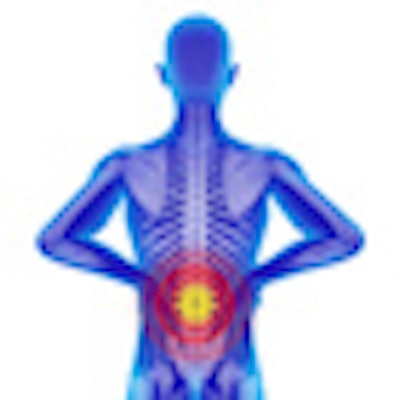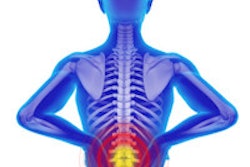
Radiologists from Leeds, U.K., are using audits to reduce the alarming number of lumbar spine radiographs that may be unnecessary, thereby reducing radiation exposure to patients and freeing up x-ray machines and radiographers for more urgent examinations.
Long-term low back pain remains a common presentation for practitioners to deal with in both primary care and musculoskeletal services. As a result, there is a high number of referrals for lumbar spine radiographs that are of little diagnostic value and result in exposure to a significant radiation dose (range 3-4 units), Dr. M. C. Cooke, from the Leeds Teaching Hospitals National Health Service (NHS) Trust, told delegates at last week's U.K. Radiological Congress (UKRC) in Manchester.
Despite the publication of guidelines, such as those from the U.K. National Institute for Health and Clinical Excellence (NICE), on the imaging of long-term low back pain, a significant number of lumbar spine film referrals remains. This leads to unnecessary radiation exposure for patients and significant costs, Cooke noted.
The Leeds group carried out an audit that retrospectively analyzed 120 general practitioner (GP) referrals for lumbar spine radiographs in patients between ages 19.6 years and 58.3 years. They looked at a one-week period in September 2011. Information was collected from the request card, the report findings for each radiograph, and any subsequent follow-up in secondary care. Requests were grouped into categories according to NICE guidelines: acute, suspected fracture, suspected malignancy, radiculopathy, and nonspecific low back pain.
The researchers found that a total of 81% of referrals did not meet the guidelines set out by NICE. About 63% of referrals had no indication for any imaging, while the remaining 18% met indications for suggested MRI consideration without unnecessary radiographs. Of the patients, 46 had request cards for multiple radiographs, and 13 were followed up with further imaging, nine of which included MRI.
When referral requests were grouped according to NICE guidelines, 11 were acute, 74 were nonspecific low back pain, 16 were radiculopathy, 11 were suspected fractures, and six were suspected malignancies.
The report findings were degenerative changes (65% of patients), normal (25%), old fracture (4%), osteoporosis (2%), malignancy (2%), and acute fracture (2%).
"The data were presented at the local audit meeting," Cooke noted. "GPs have previously been informed of similar results from other audits via a letter or message attached to reports, which highlighted salient points and directed them to guidelines which proved to be ineffective at reaudit. Ongoing discussion is therefore under way considering implementation of various interventions, such as radiographers screening radiograph requests and information being returned to the GP/patient if the requested imaging modality is not deemed appropriate."
The anticipated outcome of the process is a reduction in radiation exposure to patients. The aim is also to free up radiographers and x-ray machines, given that the evidence suggests approximately 5,054 potentially unnecessary lumbar spine films per annum are performed in the city of Leeds. Cooke also hopes the audit will reduce time spent reporting lumbar spine films for radiologists and save the trust money associated with the investigation of long-term, nonspecific lower back pain. The plan is to reaudit six months postfinalized intervention.
To read the NICE guidelines from 2009, click here.



















